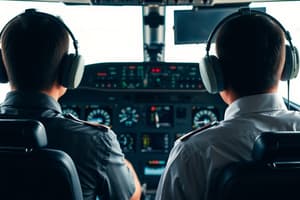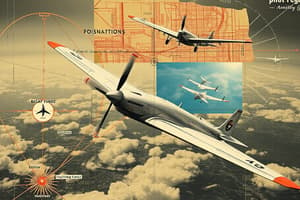Podcast
Questions and Answers
The final authority as to the operation of an aircraft is the?
The final authority as to the operation of an aircraft is the?
pilot in command
When must a pilot who deviates from a regulation during an emergency send a written report of that deviation to the Administrator?
When must a pilot who deviates from a regulation during an emergency send a written report of that deviation to the Administrator?
upon request
When would a pilot be required to submit a detailed report of an emergency which caused the pilot to deviate from an ATC clearance?
When would a pilot be required to submit a detailed report of an emergency which caused the pilot to deviate from an ATC clearance?
When requested by ATC
If an in-flight emergency requires immediate action, what may the pilot in command do?
If an in-flight emergency requires immediate action, what may the pilot in command do?
Who is responsible for determining if an aircraft is in condition for safe flight?
Who is responsible for determining if an aircraft is in condition for safe flight?
During your preflight, who is responsible for determining the mechanical discrepancy that makes the aircraft unworthy?
During your preflight, who is responsible for determining the mechanical discrepancy that makes the aircraft unworthy?
Where may an aircraft's operating limitations be found?
Where may an aircraft's operating limitations be found?
Under what conditions may objects be dropped from an aircraft?
Under what conditions may objects be dropped from an aircraft?
What is the acceptable blood alcohol level for flying after consuming alcoholic drinks?
What is the acceptable blood alcohol level for flying after consuming alcoholic drinks?
No person may act or attempt to act as a crewmember of a civil aircraft with a blood alcohol level of?
No person may act or attempt to act as a crewmember of a civil aircraft with a blood alcohol level of?
A person may not act as a crewmember of a civil aircraft if alcoholic beverages have been consumed within the preceding?
A person may not act as a crewmember of a civil aircraft if alcoholic beverages have been consumed within the preceding?
While experiencing a hangover, how will a pilot's abilities be affected?
While experiencing a hangover, how will a pilot's abilities be affected?
What should preflight action, as required for all flights away from the vicinity of an airport, include?
What should preflight action, as required for all flights away from the vicinity of an airport, include?
What must a pilot in command determine in addition to other preflight actions for a VFR flight away from the departure airport?
What must a pilot in command determine in addition to other preflight actions for a VFR flight away from the departure airport?
As a pilot in command of a VFR flight, what must you obtain as part of your preflight planning?
As a pilot in command of a VFR flight, what must you obtain as part of your preflight planning?
Which preflight action is specifically required of the pilot prior to each flight?
Which preflight action is specifically required of the pilot prior to each flight?
For a VFR flight not in the vicinity of an airport, what must the pilot in command do?
For a VFR flight not in the vicinity of an airport, what must the pilot in command do?
What describes the flight conditions under which pilots are required to keep their safety belts and shoulder harnesses fastened?
What describes the flight conditions under which pilots are required to keep their safety belts and shoulder harnesses fastened?
Flight crewmembers are required to keep their safety belts fastened during?
Flight crewmembers are required to keep their safety belts fastened during?
The pilot in command is responsible for ensuring that each person onboard is briefed on?
The pilot in command is responsible for ensuring that each person onboard is briefed on?
Safety belts are required to be properly secured about which persons in an aircraft, and when?
Safety belts are required to be properly secured about which persons in an aircraft, and when?
What obligation does a pilot in command have concerning the use of safety belts for passengers?
What obligation does a pilot in command have concerning the use of safety belts for passengers?
With certain exceptions, when are safety belts required to be secured about passengers?
With certain exceptions, when are safety belts required to be secured about passengers?
Pre-takeoff briefing of passengers for a flight is the responsibility of?
Pre-takeoff briefing of passengers for a flight is the responsibility of?
What is the pilot in command responsible for concerning each person on board regarding safety belts?
What is the pilot in command responsible for concerning each person on board regarding safety belts?
No person may operate an aircraft in formation flight except by?
No person may operate an aircraft in formation flight except by?
Which statement is true regarding formation flights?
Which statement is true regarding formation flights?
If an airplane and an airship are converging, and the airship is left of the airplane's position, which has the right of way?
If an airplane and an airship are converging, and the airship is left of the airplane's position, which has the right of way?
When two or more aircraft are approaching an airport for landing, who has the right-of-way?
When two or more aircraft are approaching an airport for landing, who has the right-of-way?
Which aircraft—glider, airship, or aircraft refueling other aircraft—has the right of way?
Which aircraft—glider, airship, or aircraft refueling other aircraft—has the right of way?
What action should the pilots of a glider and an airplane take if on a head-on collision course?
What action should the pilots of a glider and an airplane take if on a head-on collision course?
What is required when two aircraft of the same category converge, but not head-on?
What is required when two aircraft of the same category converge, but not head-on?
Which aircraft—airship, aircraft towing other aircraft, or gyroplane—has right of way over the others?
Which aircraft—airship, aircraft towing other aircraft, or gyroplane—has right of way over the others?
Which aircraft—balloon, aircraft in distress, or aircraft on final approach to land—has right of way over all others?
Which aircraft—balloon, aircraft in distress, or aircraft on final approach to land—has right of way over all others?
If a seaplane and a motorboat are on crossing courses, and the motorboat is to the left of the seaplane, which has right of way?
If a seaplane and a motorboat are on crossing courses, and the motorboat is to the left of the seaplane, which has right of way?
What is the minimum safe altitude required for a pilot to operate an aircraft anywhere?
What is the minimum safe altitude required for a pilot to operate an aircraft anywhere?
What is the minimum safe altitude for a pilot to operate an aircraft over congested areas?
What is the minimum safe altitude for a pilot to operate an aircraft over congested areas?
What is the minimum safe altitude required for a pilot to operate an aircraft over other than a congested area?
What is the minimum safe altitude required for a pilot to operate an aircraft over other than a congested area?
According to 14 CFR part 91, at what minimum altitude may an airplane be operated unless necessary for takeoff and landing?
According to 14 CFR part 91, at what minimum altitude may an airplane be operated unless necessary for takeoff and landing?
What is the minimum distance an aircraft may not operate closer than to any person, vessel, vehicle, or structure?
What is the minimum distance an aircraft may not operate closer than to any person, vessel, vehicle, or structure?
Prior to takeoff, the altimeter should be set to which altitude or altimeter setting?
Prior to takeoff, the altimeter should be set to which altitude or altimeter setting?
If an altimeter setting is not available before flight, to which altitude should the pilot adjust the altimeter?
If an altimeter setting is not available before flight, to which altitude should the pilot adjust the altimeter?
What action is appropriate if the pilot deviates from an ATC instruction during an emergency and is given priority?
What action is appropriate if the pilot deviates from an ATC instruction during an emergency and is given priority?
When an ATC clearance has been obtained, may a pilot in command deviate from that clearance?
When an ATC clearance has been obtained, may a pilot in command deviate from that clearance?
Flashcards are hidden until you start studying
Study Notes
Pilot Responsibilities and Authority
- The pilot in command (PIC) holds the final authority regarding aircraft operation.
- It is the PIC's responsibility to determine the aircraft's safety for flight, including preflight discrepancies.
- If emergency actions are required, the PIC may deviate from 14 CFR 91 regulations as needed.
Emergency Procedures
- A written report to the Administrator of any deviation during an emergency is required only upon request.
- ATC may require a detailed report if a deviation from clearance is made during an emergency.
Alcohol Regulations
- Pilots must ensure their blood alcohol level is below 0.04% to act as a crewmember.
- No alcohol consumption is allowed within eight hours prior to acting as a crewmember.
- Hangovers can impair motor and mental responses, prohibiting safe flight operations.
Preflight Requirements
- Preflight action must include an alternate plan if the flight cannot proceed as intended.
- For VFR flights away from the departure airport, the PIC must know runway lengths and aircraft performance data.
- Conduct thorough weather assessments and fuel requirements before flight.
Safety Belt Regulations
- Safety belts must be secured for all passengers during taxi, takeoffs, and landings; fogging safety briefings is the PIC's responsibility.
- Flight crewmembers must keep safety belts fastened during takeoffs and landings; shoulder harnesses must remain fastened during takeoffs and landings as well.
Right-of-Way Rules
- In converging scenarios, the airship has right-of-way over airplanes.
- The aircraft at a lower altitude has right-of-way when landing, but must not overtake others.
- When two aircraft of the same category converge, the one on the left should yield.
Minimum Safe Altitudes
- The minimum safe altitude allows for emergency landings without hazards; over congested areas, maintain at least 1,000 feet above obstacles.
- Over non-congested areas, stay at least 500 feet AGL or maintain a safe distance from people or structures.
Altimeter Settings
- Prior to takeoff, altimeters must be adjusted to the local setting or airport elevation.
- If no setting is available, adjust the altimeter to the departure area elevation.
ATC Instructions
- Deviating from an ATC instruction is permitted only in emergencies; a detailed report to ATC is required if requested after such action.
Studying That Suits You
Use AI to generate personalized quizzes and flashcards to suit your learning preferences.




